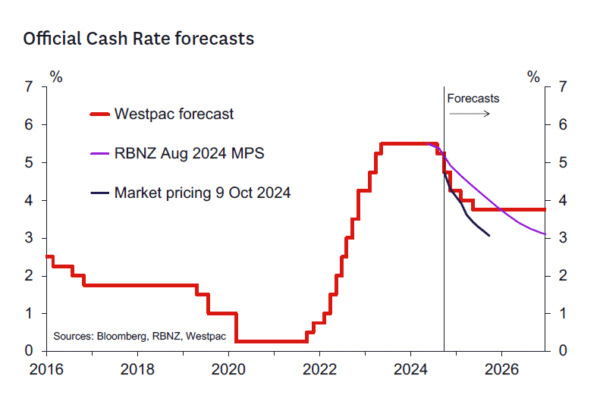- Today the RBNZ cut the OCR by 50bps to 4.75%, meeting Westpac and market expectations.
- According to the RBNZ the economy is now in a position of excess capacity, encouraging price- and wage-setting to adjust to a lowinflation economy.
- Economic activity was described as “subdued”, with business and consumer spending “weak” and employment conditions continuing to “soften”. That weakness was partly ascribed to restrictive monetary policy.
- The MPC agreed that a 50bp easing was most consistent with meeting the inflation target and avoiding unnecessary instability in output, employment, interest rates, and the exchange rate.
- We continue to forecast a further 50bps cut in the OCR on 27 November, and that the OCR will fall to a low of 3.75% in the first half of next year.
OCR cut 50bps as expected as inflation risks move into better balance.
Going into today’s RBNZ policy review, the only question was the size of the OCR cut that the Bank would choose to deliver. As it turns out, the RBNZ chose to cut the OCR by 50bps to 4.75%, as was expected by Westpac, most economists and as largely priced by markets. And looking ahead, the brief policy statement and the record of meeting indicate that a further cut in the OCR of 50bps can reasonably be expected at the next meeting on 27 November, provided that the dataflow over coming weeks prints broadly in line with our expectations (see further below).
In the accompanying brief policy statement, the RBNZ described economic activity as “subdued”, in part due to restrictive monetary policy. Business investment and consumer spending were described as “weak”. The RBNZ also noted that employment conditions were continuing to “soften”. On a more positive note, it was recognised that some exporters have benefited from improved export prices. However, this was balanced by the observation that global economic growth remains “below trend”. The RBNZ stated that “The outlook for the United States and China is for growth to slow, while geopolitical tensions remain a significant headwind for world economic activity.” Importantly, the RBNZ estimates that the New Zealand economy is now in a position of excess capacity, “…encouraging price- and wage-setting to adjust to a low-inflation economy”, with disinflation assisted by lower import prices.
Further nuance on the key factors considered by the Bank’s Monetary Policy Committee (MPC) in arriving at today’s decision can be found in the unusually brief “record of meeting”. The MPC discussed the respective benefits of a 25bps versus a 50bps cut in the OCR. They agreed that a 50bps cut “…at this time is most consistent with the Committee’s mandate of maintaining low and stable inflation, while seeking to avoid unnecessary instability in output, employment, interest rates, and the exchange rate. The Committee noted that current shortterm market pricing is consistent with this decision.”
The market has reacted to the RBNZ’s decision and message with a modest decline in wholesale interest rates and the NZ dollar. Thirty minutes post the announcement, the 2Y swap has fallen 7bps to 3.64% with the RBNZ’s 27 November meeting now closely to fully priced for a further 50bps rate cut. The NZD/USD has declined by around 25pips.
Our assessment: a further 50bps cut likely at the 27 November MPS meeting.
The RBNZ has delivered as expected. The RBNZ’s assessment is that there isn’t a benefit to maintaining a slow 25bp per meeting pace given that output and employment remain weak, and inflation looks set to print close to 2% very soon. The RBNZ continues to consider the OCR at 4.75% as restrictive.
We saw no pushback on our expectation (and market pricing) for another 50 bp easing at the November Monetary Policy Statement. Hence this remains the modal expected outcome.
The RBNZ rightly notes that their future policy decisions will be influenced by the data to come. The CPI (16 October) and the Labour market reports (6 November) are most prominent to watch out for. We don’t see outcomes in those reports that will push the RBNZ from a further 50bp easing in the November 27 meeting.
Key data and events ahead.
Ahead of the RBNZ’s next policy review several key data releases and events are scheduled. The following seem most important:
- Q3 CPI (16 October): Ahead of the September Selected Prices Indexes (released this Friday), we currently think that the CPI will print close to the 2.3%y/y forecast made by the RBNZ in the August MPS. The October Selected Price Indexes will also be released ahead of the RBNZ’s next policy meeting.
- RBNZ speech on the transmission of policy (16 October): RBNZ Assistant Governor Karen Silk will give an on the record speech on the transmission of monetary policy to financial conditions, which may provide some insights as to how the RBNZ is viewing financial conditions in the wake of recent rate cuts.
- Q3 labour market data (6 November): We presently forecast a rise in the unemployment rate to 5.0%, matching the RBNZ’s August MPS forecast. News on developments in labour costs will also be of interest, to confirm that growth is slowing in response to looser labour market conditions.
- Q4 RBNZ expectations survey (11 November): A large decline in inflation expectations over the past two surveys has contributed to the RBNZ’s dovish change in stance, so the updated survey will also be of interest.
- Global events: The US election on 5 November and Federal Reserve policy meeting on 7 November will have implications for the economic outlook and financial markets. Any further stimulus measures announced by China could also be important.
In addition to the above, we expect the RBNZ will pay very close attention to high frequency measures of business activity (such as the Business NZ PMIs, ANZ business survey) and of behaviour in the consumer sector (electronic card spending and housing market activity and prices). Developments in key export and import commodity prices and broader financial conditions (including the exchange rate) will also be relevant.














